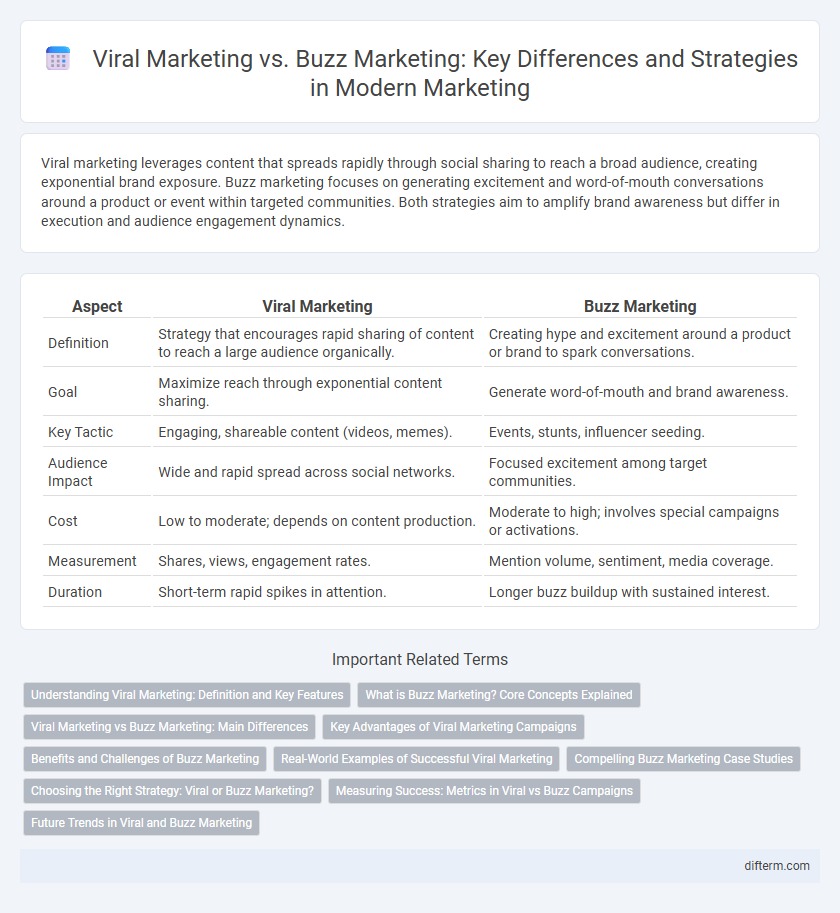Viral marketing leverages content that spreads rapidly through social sharing to reach a broad audience, creating exponential brand exposure. Buzz marketing focuses on generating excitement and word-of-mouth conversations around a product or event within targeted communities. Both strategies aim to amplify brand awareness but differ in execution and audience engagement dynamics.
Table of Comparison
| Aspect | Viral Marketing | Buzz Marketing |
|---|---|---|
| Definition | Strategy that encourages rapid sharing of content to reach a large audience organically. | Creating hype and excitement around a product or brand to spark conversations. |
| Goal | Maximize reach through exponential content sharing. | Generate word-of-mouth and brand awareness. |
| Key Tactic | Engaging, shareable content (videos, memes). | Events, stunts, influencer seeding. |
| Audience Impact | Wide and rapid spread across social networks. | Focused excitement among target communities. |
| Cost | Low to moderate; depends on content production. | Moderate to high; involves special campaigns or activations. |
| Measurement | Shares, views, engagement rates. | Mention volume, sentiment, media coverage. |
| Duration | Short-term rapid spikes in attention. | Longer buzz buildup with sustained interest. |
Understanding Viral Marketing: Definition and Key Features
Viral marketing is a strategy that encourages individuals to share promotional content rapidly across social networks, leveraging word-of-mouth to achieve exponential reach. Its key features include high shareability, emotional engagement, and content designed to evoke curiosity or strong reactions, driving organic distribution. Unlike buzz marketing, which creates immediate excitement around a product, viral marketing focuses on sustained, widespread dissemination through user participation.
What is Buzz Marketing? Core Concepts Explained
Buzz marketing centers on generating word-of-mouth excitement by creating unique, memorable experiences that spark conversations among consumers. It leverages emotional engagement and social interaction, often through unexpected or unconventional campaigns, to amplify brand visibility organically. The core concept relies on consumers becoming advocates who voluntarily share and promote the message within their networks.
Viral Marketing vs Buzz Marketing: Main Differences
Viral marketing leverages digital platforms to create content that spreads rapidly through user sharing, aiming for exponential reach and engagement. Buzz marketing focuses on generating excitement and word-of-mouth around a product or event, often through targeted experiences or influencer endorsements to spark conversations. The main difference lies in viral marketing's reliance on organic, scalable online sharing versus buzz marketing's strategic, often localized efforts to stimulate immediate consumer interest.
Key Advantages of Viral Marketing Campaigns
Viral marketing campaigns leverage social networks and compelling content to achieve rapid, exponential reach, driven by user sharing and organic growth. Key advantages include cost-effectiveness, heightened brand awareness, and enhanced engagement, as messages spread without heavy media expenditure. This approach fosters authentic consumer interaction, increasing trust and the likelihood of conversion through peer recommendations.
Benefits and Challenges of Buzz Marketing
Buzz marketing generates organic word-of-mouth excitement by leveraging authentic consumer experiences, resulting in increased brand awareness and customer trust. Its benefits include higher engagement rates and cost-effectiveness, while challenges involve controlling the message, managing potential negative feedback, and maintaining genuine enthusiasm over time. Successful buzz marketing campaigns require careful monitoring and agile responses to sustain positive momentum and mitigate risks.
Real-World Examples of Successful Viral Marketing
Viral marketing campaigns like the ALS Ice Bucket Challenge and Dollar Shave Club's launch video demonstrate the power of shareable content that sparks widespread online engagement and brand awareness. These campaigns leverage emotional appeal and humor to encourage user participation, significantly amplifying reach through social media platforms. Metrics such as exponential increases in social shares, user-generated content, and rapid audience growth highlight their effectiveness compared to traditional buzz marketing strategies.
Compelling Buzz Marketing Case Studies
Compelling buzz marketing case studies demonstrate how brands ignite consumer conversations through authentic, localized experiences that foster organic engagement and brand advocacy. Successful examples include Coca-Cola's "Share a Coke" campaign, which personalized packaging to spark social sharing, and Red Bull's extreme sports events that create immersive, attention-grabbing moments driving widespread word-of-mouth. These cases highlight buzz marketing's ability to generate sustained interest by leveraging real-time consumer interactions without relying solely on viral content's rapid but often short-lived spread.
Choosing the Right Strategy: Viral or Buzz Marketing?
Choosing the right strategy between viral marketing and buzz marketing depends on your brand goals and audience engagement. Viral marketing relies on creating highly shareable content that spreads rapidly across social media platforms, maximizing reach and exposure. Buzz marketing focuses on generating excitement and word-of-mouth through targeted influencer partnerships and experiential campaigns, fostering deeper emotional connections with consumers.
Measuring Success: Metrics in Viral vs Buzz Campaigns
Viral marketing success is often measured by metrics such as shares, views, and engagement rates, reflecting rapid and widespread content dissemination. Buzz marketing metrics focus on tracking brand mentions, sentiment analysis, and word-of-mouth referrals to gauge consumer excitement and conversation volume. Both strategies require monitoring conversion rates and ROI to assess overall campaign effectiveness and impact on brand awareness.
Future Trends in Viral and Buzz Marketing
Emerging AI-driven personalization technologies are revolutionizing viral marketing by enabling hyper-targeted content that boosts shareability and engagement rates across social media platforms. Buzz marketing is increasingly leveraging immersive experiences, such as augmented reality and live virtual events, to create memorable brand interactions that spark organic conversations. Future trends emphasize integrating data analytics and influencer collaborations to amplify message virality and sustain prolonged consumer interest.
Viral marketing vs buzz marketing Infographic

 difterm.com
difterm.com